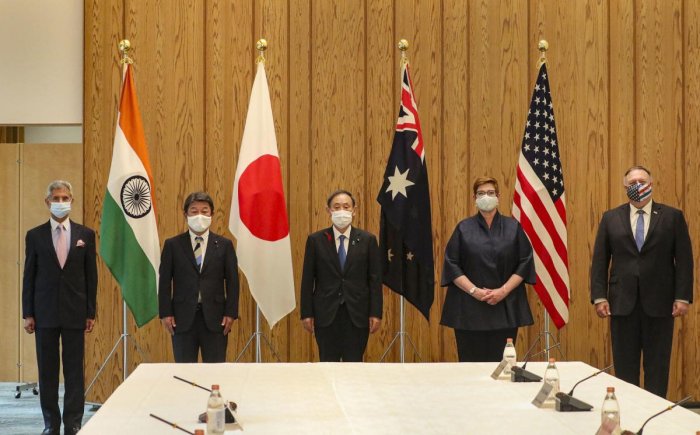
SOURCE: DECAN HERALD
Speaking at a meeting of the foreign ministers of the Quad (Australia, India, Japan and United States) countries in Tokyo on October 6, US Secretary of State Mike Pompeo urged: “As partners in the Quad, it is more critical now that we collaborate to protect our people and partners from the Chinese Communist Party’s (CCP) exploitation, corruption and coercion.”
The other three countries did not reciprocate Pompeo’s sentiments. Japan’s chief government spokesman Katsunobu Kato stated: “This Quad meeting is not being held with any particular country in mind.” The Australian foreign minister made no public mention of such concerns. Indian foreign minister S Jaishankar focused on the need for “like-minded countries to coordinate responses to various challenges” and advance their security and economic interests.
The Quad’s first “exploratory meeting” was held in May 2007 on the sidelines of an ASEAN Regional Forum meeting in Manila without any formal agenda or a joint statement or plans for future meetings. Thereafter, the Quad receded into the background under the weight of domestic politics in the member countries. It was revived in late 2017 after these four countries witnessed increasing spats with China over political, trade, and border disputes.
The Quad senior officials met twice a year in 2018 and 2019; in January 2018, the naval chiefs of the four countries were assembled together at the Raisina Dialogue in New Delhi; in September 2019, the four countries held their first meeting at foreign minister level in New York on the sidelines of the UN General Assembly session. In November 2019, the four capitals hosted the first Quad counterterrorism exercise; in March 2020, they exchanged views on controlling the Covid-19 pandemic.
Threat perceptions
Though the Quad countries agree that recent Chinese policies and actions constitute a threat to their interests, there are sharp divergences on the nature of the threat due to their geographic proximity, territorial disputes, potential risk of, and ability to withstand, retaliation by China. Japan has a dispute with China over the Senkaku islands; it has bolstered its defence capabilities but due to its pacifist constitution, it cannot depute its self-defence forces (SDF) to fight on the territory of another Quad member.
Australia has no direct territorial disputes with China and gets comfort from its alliance with the US; it has relied on the US to play the role of external balancer in the region, but this role is coming under strain as Chinese national power and assertiveness grows.
The US views China as a “revisionist” State challenging its global supremacy and trying to alter the rules of the US-led post-war liberal international order. While the Trump administration has upped its defence spending, it has told its allies and partners not to depend solely on the US and to augment their own military capabilities. Today, its closest allies like Japan, Australia, Taiwan and others are unsure if “a tired and withdrawing” US would intervene in their favour, in case of a military conflict with China.
Among the four Quad countries, India is the frontline State with the maximal adversarial relationship with China. The latter’s ability to inflict costs on India makes her reticent in taking any anti-China initiative. India has a 3,500-km land border with China, which the latter has refused to demarcate despite numerous rounds of border talks. In case of a military conflict with China, India will have to fight on its land borders all by itself.
As India’s greatest threats are in its immediate region, India has deployed most of its military assets towards countering these threats first. The Indian Navy is left with little resources to project its capabilities in the South China Sea. India has no desire to provoke China in secondary theatres of concern that could invite bigger retribution in its own neighbourhood.
India also has to be mindful of the reaction of its traditional defence partner, Russia, which is opposed to the Quad. Also, there are other important partners such as the UK, France and Germany who have significant interests in the Indo-Pacific region but are yet to fully spell out their strategy for it.
Strategic orientation
Participating in a discussion at the Asia Society, New York, in March 2019, Jaishankar, then the Tata Group’s president of Global Corporate Affairs, had said that the “Quad was intended as a forum for diplomatic consultation and coordination among countries who have convergences with substantial common ground. Assigning to Quad, roles and responsibilities such as weaponisation or naval security were misunderstandings which were never intended for the Quad.” We should leave it there and not expect unrealistic objectives from the Quad.
At their Tokyo meeting, the Quad countries agreed to increase practical cooperation on maritime, cybersecurity, counterterrorism, data flows, critical technologies, resilient supply chains and quality infrastructure to reduce their dependence on China.
It is quite clear that the current orientation of three Quad countries (excluding the US) is towards a more open and inclusive regime, without naming China, though most Quad activities are aimed at reducing China’s preponderance in both economic and security spheres. These countries want to maintain their cooperative ties with both the US and China; they want to find a solution to their security-related problems with China, bilaterally.
As regards the future, much will depend on how China’s aggression and assertiveness play out and its impact on the economic and security imperatives of these countries as well as what approaches the next US President would take to push back against China and the assistance it would be willing to provide to the Quad countries.
Former foreign secretary Shyam Saran recently observed that the “Quad is a fallback if China continues to seek unilateral dominance as a means to ensure its security.” In that case, we may see an incremental deepening of the Quad’s activities, with the inclusion of more countries to counter China’s aggression.
(The writer is a former Indian Ambassador)






